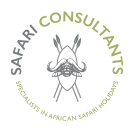It’s been an unfortunate journey for Zimbabwe since independen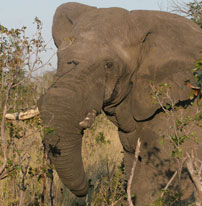 ce in the early 1980’s. The initial optimism, growth, and prosperity which produced Africa’s finest safari guides and offered a great wildlife experience was gradually eroded away by a dictator and his henchmen until it came to a head around the turn of the Century when the economy collapsed, the ‘brain-drain’ for the fortunate who could get out started, and the fight for survival of the man in the street began in earnest.
ce in the early 1980’s. The initial optimism, growth, and prosperity which produced Africa’s finest safari guides and offered a great wildlife experience was gradually eroded away by a dictator and his henchmen until it came to a head around the turn of the Century when the economy collapsed, the ‘brain-drain’ for the fortunate who could get out started, and the fight for survival of the man in the street began in earnest.
Having hit rock bottom, and switching to the currency to the US Dollar, many people had expressed a real optimism for the future and so I decided it was time to travel back to experience the country and in particular, the state of the safari industry.
Landing in Victoria Falls was seemingly no different to that of my last visit. The airport was undergoing a rebuild (by the Chinese), and having passed easily through customs and immigration I was greeted by the thunderous song and dance of the local dance troop.
Leaving the airport, it was immediately noticeable that the curio vendors which used to line the streets had disappeared, replace by a sole vendor selling vegetable squash. Was this indicative of the drop in tourism?
 After a stop to visit the new The Elephant Camp, the next most notable thing was the new housing developments on the outskirts of Victoria Falls town. However, entering the town was a little like going back in time, nothing was seemingly out of place since my last visit. On closer inspection, many of the hotels had been refurbished, even re-developed, and were actually in very good condition. New properties out of town had been built recently, and even the old Sprayview was said to be under new ownership with an extensive upgrade programme in place. Certainly it did not look like a country in a state of collapse.
After a stop to visit the new The Elephant Camp, the next most notable thing was the new housing developments on the outskirts of Victoria Falls town. However, entering the town was a little like going back in time, nothing was seemingly out of place since my last visit. On closer inspection, many of the hotels had been refurbished, even re-developed, and were actually in very good condition. New properties out of town had been built recently, and even the old Sprayview was said to be under new ownership with an extensive upgrade programme in place. Certainly it did not look like a country in a state of collapse.
I travelled up the Zambezi to Imbabala Zambezi Safari Lodge, near the Kazangula border, where I spent a pleasant enough night before travelling back to Victoria Falls for a night. I inspected are few new developments upstream of the falls themselves so the indication is that people are investing.
An early start saw me being met by professional guide 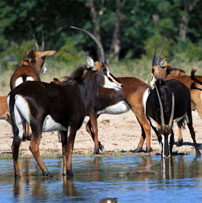 Dave Carson for the drive through to his new camp in the western Hwange National Park. The drive was easy and straightforward and we passed through the ‘new’ toll gate (three tenders huddled around a fire at a ram shackled boon) where we paid our US$1.00 (total revenue for the morning could not have been more than $15 – there were no cars or trucks on the road). Entering the park, we were greeted by a pack of wild dogs in the middle of the road. However, no cameras were at the ready and by the time we had got ourselves together, they had moved off intently into the bush. We stopped for a break at the run down Sinamatella Camp before travelling through to Camp Hwange near Shumba Pan. About 3 and a half hours door to door – certainly not an issue. Lots of ele’s and a good hide overlooking the waterhole.
Dave Carson for the drive through to his new camp in the western Hwange National Park. The drive was easy and straightforward and we passed through the ‘new’ toll gate (three tenders huddled around a fire at a ram shackled boon) where we paid our US$1.00 (total revenue for the morning could not have been more than $15 – there were no cars or trucks on the road). Entering the park, we were greeted by a pack of wild dogs in the middle of the road. However, no cameras were at the ready and by the time we had got ourselves together, they had moved off intently into the bush. We stopped for a break at the run down Sinamatella Camp before travelling through to Camp Hwange near Shumba Pan. About 3 and a half hours door to door – certainly not an issue. Lots of ele’s and a good hide overlooking the waterhole.
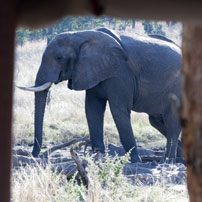 Over the next three nights I travelled through to the Main Camp region and eastern concession areas of the park. The lodges I visited were all in good order, and although I got the nagging suspicion that game numbers were much lower than I had remembered (particularly giraffe and roan), we still saw elephant in very large numbers and with a good range of ages, a lioness with cubs, a solitary leopard, a huge herd of buffalo, sizeable sable herd and a host of plains game with relative ease. I also spent some hours in the hides around various waterholes – I really should do that more often as it’s so rewarding.
Over the next three nights I travelled through to the Main Camp region and eastern concession areas of the park. The lodges I visited were all in good order, and although I got the nagging suspicion that game numbers were much lower than I had remembered (particularly giraffe and roan), we still saw elephant in very large numbers and with a good range of ages, a lioness with cubs, a solitary leopard, a huge herd of buffalo, sizeable sable herd and a host of plains game with relative ease. I also spent some hours in the hides around various waterholes – I really should do that more often as it’s so rewarding.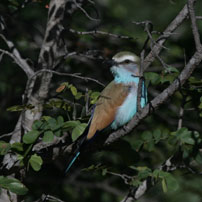
There are some very good products giving you a very good bush experience – The Hide, Somalisa Camp, Davidsons and Little Makalolo amongst them. Of the new camps in the latter throws of development, Camelthorn and Khulu Ivory looked to be of good standard although both are on the fringes of the National Park itself and I would question why you would want to be on the fringes of the park.
From Hwange, I drove through to Bulawayo – imagine a 150 miles journey with only a dozen cars and trucks for company, and of course a second US$1.00 toll gate of similar stature. There was only one section of the road which was poor – it lasted for around 50 metres.
Bulawayo, however, was a bit of a ‘ghost town’ – I learnt later that the population had halved in the latest census, a result of the main industries relocating to the Harare area. No doubt the workforce followed. None-the-less, those hotels within the city still offered acceptable standards but if visiting here it’s preferable to be in one of the lodges bordering the Matobo Hills National Park. Both Amalinda and Big Cave are ‘from the past’ but provide good bases from which to explore the region, noted for its San rock art, black eagle and rhino populations, and the historical references to Cecil John Rhodes (and his grave).
So in short I was mildly surprised at the quality of the lodges and the guiding, and although it’s certainly not what it used to be at the end of the last Century, the prices are keen and it represents very good value, particularly if you’re happy to take the time to drive and take any internal flights.
